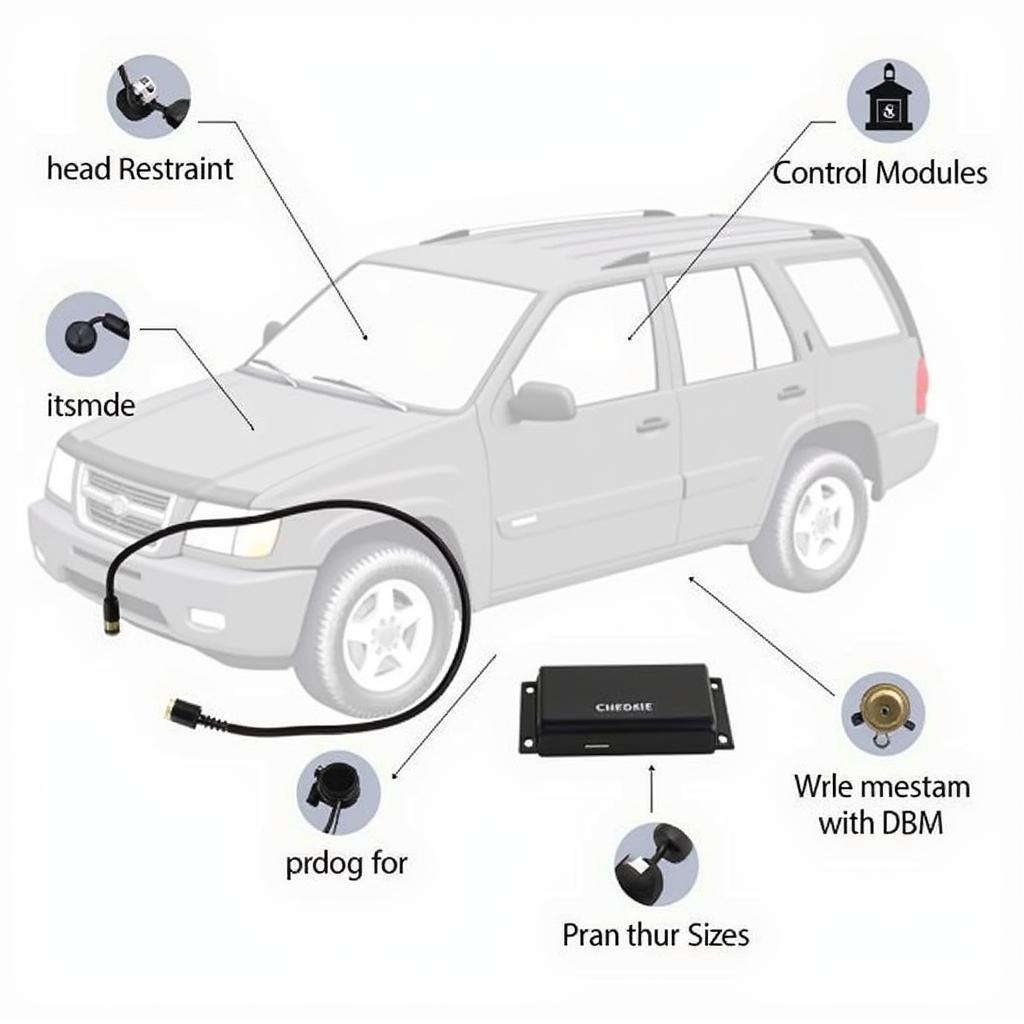Is your Mercedes-Benz GLA giving you a bumpy ride? A smooth, comfortable ride is one of the hallmarks of a Mercedes-Benz, and a compromised suspension can quickly detract from that experience. If you’re experiencing a rougher-than-usual ride in your 4MATIC GLA, this guide will walk you through potential causes, symptoms, and possible solutions.
Understanding the 4MATIC Suspension System
Before diving into troubleshooting, it’s helpful to understand the basics of your GLA’s 4MATIC suspension. This system isn’t just about delivering power to all four wheels; it plays a crucial role in handling, stability, and ride quality. The 4MATIC system, combined with a sophisticated suspension setup, ensures your GLA stays planted on the road, whether you’re navigating corners or cruising on the highway.
Common Causes of Suspension Problems in a Mercedes-Benz GLA
Several components work together to ensure your GLA delivers a smooth ride. Here are some of the common culprits behind suspension troubles:
- Worn Shocks or Struts: Shocks and struts are your first line of defense against bumps and dips in the road. Over time, they wear down, reducing their ability to dampen impacts, leading to a bouncier, less controlled ride.
- Damaged or Leaking Springs: Your GLA’s suspension springs help maintain ride height and absorb shocks. A broken or leaking spring can significantly impact handling and ride comfort.
- Worn Control Arm Bushings: Control arms connect the wheels to the suspension system. Their bushings, or rubber isolators, wear out over time, leading to clunking noises and imprecise steering.
- Stabilizer Bar Link Issues: Stabilizer bars help control body roll during cornering. Worn links or bushings in this system can lead to a clunking sound, especially when driving over bumps.
- Wheel Bearing Wear: While not directly part of the suspension, worn wheel bearings can produce humming or grinding noises that are easily mistaken for suspension problems.
Identifying Suspension Problems: What to Look and Listen For
Your Mercedes-Benz GLA will often give you clues when the suspension needs attention. Keep an eye (and ear) out for these common symptoms:
- Excessive Bouncing: Does your GLA keep bouncing after hitting a bump? This is a telltale sign of worn shocks or struts.
- Nosediving When Braking: If your GLA dips excessively when you apply the brakes, it could point to worn-out front suspension components.
- Uneven Tire Wear: Suspension problems can cause your tires to wear unevenly. If you notice this, it’s crucial to have your suspension inspected.
- Pulling to One Side: A misaligned suspension can cause your GLA to pull to one side while driving.
- Knocking or Clunking Noises: Any unusual noises, particularly when driving over bumps or turning, should be investigated, as they could signal worn bushings or other suspension component issues.
Essential Tools for Diagnosing and Fixing Suspension Issues
While some suspension repairs require specialized tools and expertise, you can diagnose and even address some issues with the help of:
- Car Jack and Jack Stands: These are essential for safely lifting your GLA to inspect suspension components.
- Lug Wrench: You’ll need this to remove the lug nuts holding your wheels in place.
- Socket Set and Wrenches: A variety of sockets and wrenches will be necessary for loosening and tightening suspension fasteners.
- Torque Wrench: Ensuring bolts are tightened to the correct specifications is crucial for safety and proper suspension geometry.
- Penetrating Oil: This can be a lifesaver for loosening stubborn, rusted bolts.
- A Reliable OBD2 Scanner: While not directly related to hands-on repairs, an OBD2 scanner can help identify underlying electronic issues, such as faulty sensors, that might be triggering suspension warnings. For in-depth diagnostics and access to manufacturer-specific codes, consider a professional-grade OBD2 scanner from a reputable brand like Cardiagtech.
Step-by-Step Guide to Addressing Common Suspension Issues
Disclaimer: It’s important to note that suspension work can be complex and potentially dangerous if you’re not experienced. The following steps are for informational purposes only. If you’re unsure about any aspect of the repair, it’s best to consult a qualified mechanic.
- Diagnose the Problem: Accurately identifying the issue is the first and most crucial step. Refer to the symptoms listed earlier and, if possible, use an OBD2 scanner to check for any fault codes related to your GLA’s suspension system.
- Secure Your Vehicle: Park your GLA on a level surface, engage the parking brake, and use wheel chocks to block the wheels opposite the side you’ll be working on.
- Lift and Support: Use a car jack to lift the vehicle at the designated jacking points and secure it on jack stands for maximum stability. Never work under a car supported solely by a jack.
- Inspect the Components: Carefully examine the suspected suspension components for signs of wear, damage, leaks, or loose parts. This may involve removing the wheel for a clearer view.
- Replace Worn or Damaged Parts: If you’ve identified worn shocks, struts, springs, or other components, replace them with high-quality parts designed for your specific GLA model.
- Reassemble and Torque: Carefully reinstall all removed components, ensuring bolts and nuts are tightened to the correct torque specifications using a torque wrench. This step is critical to prevent premature wear and ensure safety.
- Lower the Vehicle: Slowly lower your GLA using the car jack and remove the jack stands.
- Test Drive: After the repair, take your GLA for a test drive on a quiet road. Pay attention to any unusual noises, vibrations, or pulling sensations. If the problem persists, further diagnosis may be necessary.
 Mercedes-Benz GLA suspension system
Mercedes-Benz GLA suspension system
Frequently Asked Questions About Mercedes-Benz GLA Suspension Problems
Q: How often should I have my GLA’s suspension inspected?
A: It’s generally recommended to have your suspension inspected every 50,000 miles or as part of your regular maintenance schedule. However, driving conditions, road quality, and driving habits can all influence the wear and tear on your suspension. If you notice any of the symptoms mentioned earlier, it’s best to get it checked sooner rather than later.
Q: Can I use aftermarket suspension parts on my Mercedes-Benz GLA?
A: While using aftermarket parts might seem like a way to save money, sticking with genuine Mercedes-Benz parts or reputable OEM (Original Equipment Manufacturer) equivalents is generally recommended. These parts are designed to meet the specific engineering standards of your GLA, ensuring optimal performance, handling, and longevity.
Q: My GLA’s dashboard is displaying a suspension warning light. What does it mean?
A: A suspension warning light could indicate various issues, from a simple sensor malfunction to a more serious problem with the suspension system itself. Connecting an OBD2 scanner, such as one from CARDIAGTECH, can help you read the specific fault codes triggering the warning, giving you a better understanding of the issue.
Q: My GLA’s ride suddenly feels much harsher. What could be the cause?
A: A sudden change in ride quality could point to a broken spring or a serious leak in your shocks or struts. It’s essential to get this checked out by a qualified mechanic as soon as possible, as driving with a severely compromised suspension component can be dangerous.
 Mechanic inspecting suspension
Mechanic inspecting suspension
Taking Care of Your 4MATIC Investment
Remember, a well-maintained suspension is key to enjoying your 4MATIC Mercedes-Benz GLA’s performance, handling, and comfort for years to come. Regular inspections, prompt attention to warning signs, and proper maintenance will go a long way in keeping your GLA running smoothly and safely on the road.

